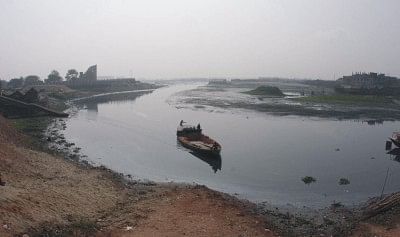Water resources in Bangladesh: 50 years of development

HOW much water is there in Bangladesh? It is unknown by volume but the known principal sources of water resources of Bangladesh are annual average rainfall of 2300 mm and daily average delta discharge of 3000 million cum seasonally partially parked in the habitats of water criss-crossed by a network of about 230 rivers.
East Pakistan Water and Power Development Authority more widely known as EPWAPDA was created in January, 1959 (EP Ordinance No. 1 of 59) for unified and coordinated development and utilisation of water and power resources in the country. After the independence of Bangladesh, the Authority was restructured into two organisations dealing with water and power separately on the 31st May, 1972 as Bangladesh Water and Power Development Boards. Taking into considerations further the rapidly changing dimensions of water resources development, the government thereafter constituted Bangladesh Water Development Board on the 11th July, 2000 as a fully autonomous organization with fresh mandate.
The BWDB's achievement during pre-Independence since 1959 is 87 projects. Until now it completed roughly 700 projects. Skimpily 14,000 Km of embankment, 13,000 appurtenant structures and 3,500 km of snaking drainage channels including huge irrigation canals have been built across the country at a cost of about $3 billion over a period of more than 50 years. Besides, BWDB has reclaimed about 1000 sq km. of land from the sea in the Meghna estuary through construction of cross-dams.
Water development projects provided increased flood-free secured land for agriculture, enhanced degree of safety to human lives, livestock, settlement, industry and infrastructure, wider accessibility, multiplicity of cropping intensity, higher crop yields, improved drainage, culture fisheries, and reduced hazards from floods and surges. Through various components under these projects, it made a total of 5.12 million Hectares of agricultural land free from flood and drainage congestion thereby facilitating production of additional food grain amounting about 5.1 million tons. Through a number of large surface water irrigation projects, it has created the necessary infrastructures for providing irrigation facilities to 1.44 million hectares thereby producing an additional food grain of about 2.5 million tons. The total additional food grain production from the completed FCD and FCDI projects is 7.6 million tons annually. This additional production is about one-third of the total food grain production in the country.
However, the benefits in terms of economic returns of most of the water development projects are shown close to zero because such assessment singly based on the agricultural output, the known objective. The other positive impacts i.e. embankment serving as roads providing micro-trading facilities, bringing qualitative changes in ecology, supporting community mobilisation, linking with national level programmes and accelerating infrastructural growth of all other sectors such as health, education, and food are not taken into account. But the population ambient to embankment and their livelihood dependent on hydrological characteristics of the region and the hydraulic behaviours of its water fronts, to the contrary, count different from what the experts say. Water development projects are never however accused by those people protected.
On the contrary, impeded drainage, reduced soil moisture ,degradation of soil-water quality, loss of flooded habitats, changes in hydrological regimes, increased agrochemical runoff, restricted navigation, increased siltation, severity of flooding, land erosion, enhanced incidence of water-borne diseases are few of the listed negative impacts. Undeniably true that inadequate consideration has been given by the water professionals to the sustainability of rivers or canals and their water quality in designing a water development project for consumptive or non-consumptive use of water culminating in fatal disruption of stream's hydraulic equilibrium.
A section of experts argue that embankment obstructing the flood pass is the main cause of flood related disasters and drainage hazards in the country and therefore stand in advocating for open channel flow; thereby managing foods by coping with floods. Observations also register that the embanking does not perform because of its failure during extreme hydraulic events, the time of its real need. Some experts, however, admit that yet the country has little option other than embankments to protect the backshores with mitigation plan drawn on environmental and social impact assessments.
Unfortunately though, during the flood every year a few water experts bring in issues making these water development projects a debatable structural intervention and then quickly disappear with the recession of floods leaving engraved the suspicion and the basic question in the minds of the politicians and the common people on the justifiability of the water development projects in totality.
It is necessary to mention that more than 20 percent of Bangladesh is annually flooded. Severe flooding may inundate 36 percent and in case of extreme hydraulic event the flooding exceeds to 68 percent. In addition to regular astronomical high tides of 2 to 6 meter, there are cyclones and cyclone generated storm surges. The already experienced climate change induced impacts within next 20 years are foreseen to permanently inundate 18 percent of the country's land mass affecting health, education and economy. The climate change induced impacts deeply relates to water issues and, therefore has come in the forefront.
The present national food requirement based on 2200 Kcal/capita/day is 28.8 million ton/year, while projected to 2030 it will be 41.9 million ton/year. Perspiring with impacts of floods on nation's economy almost every year the future challenges for the BWDB include water for food security, increased agricultural access to food, building healthy institution around the water sources, preservation of water for future generation, strong socio-political commitment to and community participation in integrated water resources management and global agreement on partnership to offer the partners an "opportunity map".
The National Water Management Plan has an analytical finding that only 2 percent incremental food production per annum is enough to meet the future demand of 40 percent absolute increased population over the next 20 years. This is achievable simply by ensuring the improved and adequate maintenance of the water resources projects. But the question now is even goes beyond: protecting life and other sector infrastructures. BWDB on completion of its 50 years of service to the nation once again needs to be restructured and re-mandated for fulfilment of government's commitment to the people of this country to have its stake-role duly played in building the "Digital Bangladesh".
The strategy for achieving the needs of the hour should now be directed towards strictly restricting BWDB within development of water resources. WARPO should be placed under the administrative control of the Planning Commission. As there is neither any need nor any feasible scope for further FCD/FCDI development, BWDB may be renamed as Coastal Development Board with fresh mandate. The management of existing all water infrastructures irrespective of their sizes and locations, initially except operation and maintenance of a few highly technical installations, should be transferred to, and placed under the administrative control of LGED for optimal benefits.
Dredging Organisation, Mechanical Equipment Organisation, River Research Institute along with some others should emerge as River Development Authority. Haor Development Board should be allowed to function independently with revised mandate on its own. Project level planning, designing, modeling etc should be further consolidated to enhance the efficiency of the support services.
Md. Saeedur Rahman is a former Chief Engineer, BWDB.

 For all latest news, follow The Daily Star's Google News channel.
For all latest news, follow The Daily Star's Google News channel. 



Comments